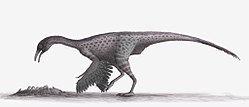Harpymimus
|
Harpymimus Temporal range: Early Cretaceous, 130 Ma |
|
|---|---|
 |
|
| Restoration of H. okladnikovi by a nest | |
| Scientific classification | |
| Kingdom: | Animalia |
| Phylum: | Chordata |
| Class: | Reptilia |
| Clade: | Dinosauria |
| Order: | Saurischia |
| Suborder: | Theropoda |
| Clade: | †Ornithomimosauria |
| Family: |
†Harpymimidae Barsbold & Perle, 1984 |
| Genus: |
†Harpymimus Barsbold & Perle, 1984 |
| Species: | †H. okladnikovi |
| Binomial name | |
|
Harpymimus okladnikovi Barsbold & Perle, 1984 |
|
Harpymimus is a basal ornithomimosaurian theropod dinosaur from the Early Cretaceous Period of what is now Mongolia. Unlike later, more derived ornithomimosaurs, Harpymimus still possessed teeth, although they appear to have been restricted to the dentary of the lower jaw.
In 1981, a Soviet-Mongolian expedition uncovered a theropod skeleton in the Gobi Desert. In 1984 this was named and shortly described by Rinchen Barsbold and Altangerel Perle as the type and only species of the new genus Harpymimus: Harpymimus okladnikovi. The generic name Harpymimus is a reference to the fearsome Harpy of Greek mythology and derived from Greek ἅρπυια (harpyia), "Harpy", and μῖμος (mimos), "mimic". The specific name honours the late Soviet archeologist Alexey Pavlovich Okladnikov.
The holotype specimen IGM 100/29 (Mongolian Academy of Sciences, Ulan Bator, Mongolia) consists of an almost complete and articulated but compressed skeleton, lacking only portions of the pectoral girdle, pelvic girdle, and hindlimbs. It was recovered in the Dundgovi Aimag (Eastern Gobi Province), from an exposure of the Shinekhudug Formation (Shinekhudag Svita or Shinekhudukskaya Svita) dating to the Hauterivian to Barremian; earlier stratification suggested a younger, Albian, age. Other dinosaurs collected from the Shinekhudug Formation in Dundgovi include the ceratopsian Psittacosaurus mongoliensis.
...
Wikipedia
